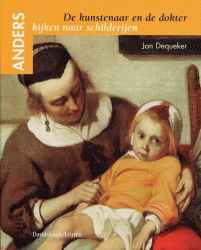
Dequeker 2006
De kunstenaar en de dokter – Anders kijken naar schilderijen (Jan Dequeker) 2006
[Davidsfonds, Louvain, 2006, 413 pages]
In this book Dequeker, professor emeritus of the Catholic University of Louvain (KUL) and specialized in rheumatology, invites the reader on a palaeopathological tour through European painting from the period 1300-1700. Palaeopathology is the science that studies diseases from ancient times that can be detected with the help of human and animal remains. Dequeker studies figures in paintings and suggests a tentative medical diagnosis for them, based on meticulous clinical observation.
On the pages 16-17 he focuses on an interesting, little-known Temptation of St Anthony (first decade of the 16th century, but according to Maurits Smeyers probably a copy after a painting dating from circa 1430-40), executed by an anonymous South Netherlandish master (Madrid, Escorial). The beggar in the lower right-hand corner is said not to suffer from ergotism (as was J. Van Lennep’s suggestion) but from an advanced state of rheumatoid arthritis.
On page 150 he discusses The repairer of bellows (circa 1556, Tournai, Musée des Beaux-Arts), a painting here attributed to Cornelis Massys. The cloth near the right eye of the repairer of bellows is said to hide a wound caused by an awl. The bent back of the old woman next to him could point to osteoarthrosis or osteoporosis of the spinal column.
Pages 276-277 deal with Hieronymus Bosch’s Cutting of the Stone panel (Madrid, Prado). This painting is said to represent the surgical removal of the ‘stone of folly’, although the quack is not ‘cutting away’ a stone, but a marsh tulip from the patient’s head.
On the pages 280-281 Dequeker focuses on the canvas Drunken man on the back of an old woman by a follower of Bosch (circa 1550, Mechelen, private collection). The man carried by the woman is said to be a sex maniac who suffers from alcoholism and the innkeeper to the right is a transvestite. Dequeker does not refer to Cat. Mechelen 2003 (cat. nr. 1).
On pages 328-329 Dequeker writes about the so-called Fourth King in the central panel of Hieronymus Bosch’s Adoration of the Magi (Madrid, Prado). The ulcerated wound (in the shape of a mint) at his lower right leg does not point to leprosy, but is said to be an ecthyma: an inflammation of the skin characterized by a fierce rash with flat carbuncles that fester and form scabs.
Pages 386-387 deal with the right wing (a Temptation of St Anthony) of Mathias Grünewald’s Isenheim Altarpiece (1512-16, Colmar, Museum Unterlinden). The diabolical figure in the lower left-hand corner is said to suffer from ergotism with dry gangreen (the fingers and the skin of the belly) and from ascites caused by the many damaged blood vessels in the liver.
On pages 388-390 Dequeker focuses on Bosch’s Temptations of st Anthony triptych. Not the Lisbon original but the Brussels copy (Royal Museums of Fine Arts), although the text does not point out that this is a copy. The blind beggar with the hurdy-gurdy in the central panel is said to suffer from the results of poliomyelitis (a viral infection of the foremost nodes of the grey matter in the spinal marrow) at the right leg and at the backbone, and also from cataract and glaucoma. The beggar with the black hat and the severed foot could suffer from ergotism or could be a malingerer.
Finally, pages 392-395 deal with the Bosch drawing Crippled beggars (Vienna, Albertina). Dequeker suggests a diagnosis for the 31 beggars in this drawing. Some of the figures can be suspected of being malingerers. About this drawing, also compare Dequeker et al. 2001.
As far as these paintings and drawing are concerned, Dequeker does not tell anything that opens up new horizons. When he is not dealing with the medical but with the iconographic aspects, more than once he seems to be rather unfamiliar with the literature about Bosch.
[explicit 6th March 2016]